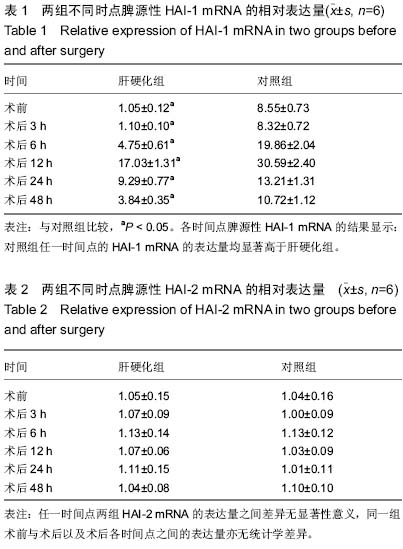| [1] Mikhail S, Cosgrove D, Zeidan A. Hepatocellular carcinoma: systemic therapies and future perspectives. Expert Rev Anticancer Ther. 2014;14(10):1-14.
[2] Fausto N, Campbell JS, Riehle KJ. Liver regeneration. J Hepatol. 2012;57(3):692-694.
[3] 宋海岩,高志涛,刘恒兴.部分肝切除大鼠不同时期肝再生组织中转化生长因子β1的表达[J].中国组织工程研究与临床康复,2010, 14(44):8257-8260.
[4] Michalopoulos GK. Liver regeneration after partial hepatectomy: critical analysis of mechanistic dilemmas. Am J Pathol. 2010; 176(1):2-13.
[5] Skarpen E, Oksvold M P, Grøsvik H, et al. Altered regulation of EGF receptor signaling following a partial hepatectomy. J Cell Physiol 2005;202(3):707-716.
[6] DeLeve LD. Liver sinusoidal endothelial cells and liver regeneration. J Clin Invest. 2013;123(5):1861-1866.
[7] 李向红,龚家明,黄世锋,等.肝硬化患者肝切除术后肝脏再生的临床研究[J].中国医师进修杂志,2011,34:29-31.
[8] Kaido T, Oe H, Yoshikawa A, et al. Expressions of molecules associated with hepatocyte growth factor activation after hepatectomy in liver cirrhosis. Hepatogastroenterology. 2003; 51(56):547-551.
[9] Oberst MD, Johnson MD, Dickson RB, et al. Expression of the serine protease matriptase and its inhibitor HAI-1 in epithelial ovarian cancer correlation with clinical outcome and tumor clinicopathological parameters. Clin Cancer Res. 2002; 8(4):1101-1107.
[10] Kataoka H, Miyata S, Uchinokura S, et al. Roles of hepatocyte growth factor (HGF) activator and HGF activator inhibitor in the pericellular activation of HGF/scatter factor. Cancer Metastasis Rev. 2003;22(2-3):223-236.
[11] Kataoka H, Shimomura T, Kawaguchi T, et al. Hepatocyte growth factor activator inhibitor type 1 is a specific cell surface binding protein of hepatocyte growth factor activator (HGFA) and regulates HGFA activity in the pericellular microenvironment. J Biol Chem. 2000;275(51):40453-40462.
[12] Parr C, Jiang WG. Hepatocyte growth factor activation inhibitors (HAI-1 and HAI-2) regulate HGF-induced invasion of human breast cancer cells. Int J Cancer. 2006;119(5): 1176-1183.
[13] Nakamura K, Hongo A, Kodama J, et al. The role of hepatocyte growth factor activator inhibitor (HAI)-1 and HAI‐2 in endometrial cancer. Int J Cancer. 2011;128(11): 2613- 2624.
[14] Higgins GM, Anderson RN. Restoration of the liver of white rat following partial surgical removel. AMA Arch Pathol. 1931;12: 186-202.
[15] Kawaguchi T, Qin L, Shimomura T, et al. Purification and cloning of hepatocyte growth factor activator inhibitor type 2, a Kunitz-type serine protease inhibitor. J Biol Chem. 1997;272 (44):27558-27564.
[16] Kirchhofer D, Peek M, Lipari MT, et al. Hepsin activates pro-hepatocyte growth factor and is inhibited by hepatocyte growth factor activator inhibitor-1B (HAI-1B) and HAI-2. FEBS Lett. 2005;579(9):1945-1950.
[17] Kaldenbach M, Giebeler A, Tschaharganeh DF, et al. Hepatocyte growth factor/ c-Met signalling is important for the selection of transplanted hepatocytes. Gut. 2012;61:1209- 1218.
[18] Wang B, Gao C, Ponder KP. C/EBPbeta contributes to hepatocyte growth factor-induced replication of rodent hepatocytes. J Hepatol. 2005;43:294-302.
[19] Huh CG, Factor VM, Sánchez A, et al. Hepatocyte growth factor/c-met signaling pathway is required for efficient liver regeneration and repair. Proc Natl Acad Sci U S A. 2004; 101(13):4477-4482.
[20] Miyazawa K, Shimomura T, Kitamura N. Activation of hepatocyte growth factor in the injured tissues is mediated by hepatocyte growth factor activator. J Biol Chem. 1996;271(7): 3615-3618.
[21] Kataoka H, Kawaguchi M. Hepatocyte growth factor activator (HGFA): pathophysiological functions in vivo. FEBS J. 2010; 277:2230-2237.
[22] Nagata K, Hirono S, Ido A, et al. Expression of hepatocyte growth factor activator and hepatocyte growth factor activator inhibitor type 1 in human hepatocellular carcinoma. Biochem Biophys Res Commun. 2001;289(1):205-211.
[23] Funagayama M, Kondo K, Chijiiwa K, et al. Expression of hepatocyte growth factor activator inhibitor type 1 in human hepatocellular carcinoma and postoperative outcomes. World J Surg. 2010;34(7):1563-1571.
[24] Ye J, Kawaguchi M, Haruyama Y, et al. Loss of hepatocyte growth factor activator inhibitor type 1 participates in metastatic spreading of human pancreatic cancer cells in a mouse orthotopic transplantation model. Cancer Sci. 2014; 105(1):44-51.
[25] Itoh H, Kataoka H, Tomita M, et al. Upregulation of HGF activator inhibitor type 1 but not type 2 along with regeneration of intestinal mucosa. Am J Physiol Gastrointest Liver Physiol. 2000;278(4):G635-G643.
[26] 郑晓筠,罗倩欣,陈倩琪,等.肝硬化部分切除后肝再生及结构变化[J].中国组织工程研究,2013,17(53):9196-9202.
[27] 杨龙,张雅敏,沈中阳.部分肝切除后肝再生的最新研究进展[J].中华肝胆外科杂志,2013,19(10):786-789.
[28] Yang S, Leow CK, Tan TM. Expression patterns of cytokine, growth factor and cell cycle-related genes after partial hepatectomy in rats with thioacetamide-induced cirrhosis. World J Gastroenterol. 2006;12:1063-1070.
[29] Tekkesin N, Taga Y, Sav A, et al. Induction of HGF and VEGF in hepatic regeneration after hepatotoxin-induced cirrhosis in mice. Hepatogastroenterology. 2011;58:971-979.
[30] Pierceall WE, Woodard AS, Morrow JS, et al. Frequent alterations in E-cadherin and alpha-and beta-catenin expression in human breast cancer cell lines. Oncogene. 1995;11(7):1319-1326.
[31] Neuhaus W, Gaiser F, Mahringer A, et al. The pivotal role of astrocytes in an in vitro stroke model of the blood-brain barrier. Front Cell Neurosci. 2014;8:352.
[32] Okumura N, Hirano H, Numata R, et al. Cell surface markers of functional phenotypic corneal endothelial cells. Invest Ophthalmol Vis Sci. 2014 [Epub ahead of print]
[33] Provost M, Brégeon J, Aubert P, et al. Effects of 1-week sacral nerve stimulation on the rectal intestinal epithelial barrier and neuromuscular transmission in a porcine model. Neurogastroenterol Motil. 2014 [Epub ahead of print].
[34] Raiko L, Leinonen P, Hägg PM, et al. Tight junctions in Hailey-Hailey and Darier's diseases.Dermatol Reports. 2009;1(1):e1.
[35] Li Y, Wei Z, Yan Y, et al. Structure of Crumbs tail in complex with the PALS1 PDZ-SH3-GK tandem reveals a highly specific assembly mechanism for the apical Crumbs complex. Proc Natl Acad Sci U S A. 2014 [Epub ahead of print].
[36] Samak G, Chaudhry KK, Gangwar R, et al. Calcium-Ask1- MKK7-JNK2-c-Src Signaling Cascade Mediates Disruption of Intestinal Epithelial Tight Junctions by Dextran Sulfate Sodium. Biochem J. 2014. |
